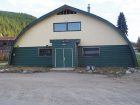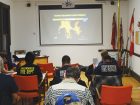
Features
Training
Editors’ pick 2015: Trainer’s Corner
In April, Greenwood Fire Rescue held a practice night that was based, in part, on Elliot Lake Fire Chief Paul Officer’s Q&A in the March issue of Fire Fighting in Canada. A quote from Chief Officer on page 16 caught my attention; “I think probably the lesson for my officers is the note-taking and detail that is required.”
May 22, 2015
By Ed Brouwer
Although note-taking wasn’t on our training schedule, I felt the need to bring it up to members sooner rather than later. I also hoped to drive home Chief Officer’s point in a more dramatic way rather than a lecture on note-taking. I’ve taken several courses on note-taking and, although it is very important, the course material is as exciting as watching paint dry.
Yes, I realize not all training should be valued in terms of excitement, however, getting all the learning senses involved helps to embed the topic into our already over-stuffed brains.
At the time, Greenwood Fire’s members were in the midst of completing a fire-behaviour module. Members had just completed exams in PPE, safety, SCBA and communications, so it was no surprise when they were asked to take out their notebooks and training manuals. After a quick review, we began fire behaviour part 2. We were six slides into my PowerPoint when our pager tone went off. (I had programmed an audio clip into the presentation.) A dispatcher’s voice called us out to a possible structure fire at 1480 Deadwood Rd. Neighbours reported smoke at the front entrance.
At first everyone just stared at me wondering what to do. I shouted, “Well? What are you waiting for? Go!” Books were closed, chairs were pushed back, orders were issued and the department responded with both engines to the reported address.
The location was the old Greenwood curling rink – a Quonset that has been sitting without purpose for a decade. The building had become a storage facility for public works. Three years ago I requested the building be given to the department for use as a training facility. With more than 465-square metres (3,000 square feet) of space, the building is a trainer’s dream. I saw great potential in the two-storey, 46.5-square metre (500-square foot) front entrance and lounge area with a layout close to a typical two-storey residence.
As firefighters arrived on scene I informed the incident commander (IC) that this was to be handled as the real deal. I wanted charged lines. I believe we should practise as if we are doing it on the fire ground; full PPE (yes, gloves too), SCBA (breathing air) and definitely charged lines. A hydrant lay was deployed and an arrival report given to dispatch (I was acting dispatch on our tactical radio channel). I recorded the timeline on a clipboard, noting time of call, time when apparatus left the hall and arrival time.
A more detailed size-up was performed (I filled in what their imaginations couldn’t see) while an interior-attack team donned SCBA. The IC chose to use the hose reel for a quick attack. An accountability person was given our new accountability board and all members handed in their tags. Entry was made on the Alpha side. They entered the main floor and after a quick and dirty lower-floor search they went up the stairs. Moving a charged line through an obstacle course of furniture and up a flight of stairs with a landing at a 90-degree turn can be difficult.
I let things evolve. I jotted down struggles and areas of uncertainty along with comments on how to better our performance. I kept quiet throughout the whole scenario. There were a few hiccups, but that is not necessarily bad. It is far better to have issues during a practice scenario than at the real call.
So here is where the practice scenario relates to the Elliot Lake lesson. I had pre-arranged for one of our firefighters, unbeknownst to the others, to quietly walk away from the main scene and lay down at the Bravo-Charlie corner of the building.
The scenario played out until the interior-attack team reached the top of the stairs and located the fire. I called it a wrap and suggested we get cleaned up. I informed the firefighters that we would debrief back at the hall. Members were still trying to figure out the purpose of this scenario. They certainly were not expecting a man down or a lesson on accountability.
Clean up went as expected and units headed back to the hall. There were a few questions as to where Pat was, but no one really pushed the point. Once back at the hall, two members actually ran back to the curling rink (which was just two blocks away). After calling out Pat’s name several times, the firefighters returned to the hall; they thought perhaps he was already up in the training room.
The person with the accountability board (who was new to Greenwood Fire) was upset because Pat’s tag was still on the board and she hadn’t said anything. Finally, we went back to the curling rink and found Pat lying at the back of the building some 200 feet up an alley.
Back at the hall we debriefed the call and highlighted a few areas of concern. I asked members to pretend we were now in court regarding the call out to 1480 Deadwood Rd. I led the questioning of certain individuals. I asked what time the call came in, what time they left the hall, what time they arrived. Did they do a size up? Was an arrival report submitted? Who was in attendance? What time was entry made? Who entered? How long before fire was located? I hammered away with these questions, then asked if there was an accountability system and asked them to describe it. I asked about Pat – where had he been, why he was missed and left behind.
Because I had recorded all the info earlier, I could challenge any made-up answers. I explained to the members that this incident had happened in the last hour and yet they struggled getting their timeline right. Now I told them to imagine it was two months or three years later and Pat’s family was suing the department for negligence. It was then the lights came on and someone said, “We should start taking notes.” Another said, “We wrote some things on the whiteboard, but we erased them when we cleaned up.”
Then I brought up the Elliot Lake lessons. We too now have a scribe (even at a practice scenario). A heart attack can happen anywhere, even at a practice night. The practice scenario taught us that accountability is our responsibility at every incident, practice or event – emergency or not. I knew our practice was successful when I overheard a junior member say, “I’ll never forget that lesson.”
Two weeks after the practice, Greenwood Fire responded to a fifth-wheel travel trailer fire in a driveway adjacent to a single-family residence. When I asked the chief for a run down three days later, he pulled out his notes and gave a minute-by-minute detailed report.
Our members may not all be note-takers, but you can bet they are taking note of what is happening around them; and that is half the battle. Stay safe out there and remember to train as if lives depend on it.
A special thanks to the Elliot Lake Fire Department.
Ed Brouwer is the chief instructor for Canwest Fire in Osoyoos, B.C., and training officer for Greenwood Fire and Rescue. Contact Ed at ebrouwer@canwestfire.org
Print this page

